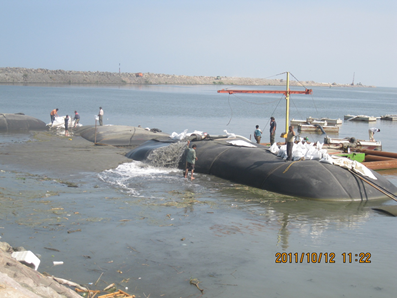مقاله مهندس اشکبوسی درباره استفاده از ژئوتیوب در موج شکنها و دایکهای ساحلی به صورت کامل در لینک زیر قرار دارد.

Geotextile Tubes as Reclamation Dykes in Bandar-e Anzali Port (Caspian sea, Iran)
 Bandar-e Anzali (Anzali Port) is a harbour town, near Rasht, on Iran’s Caspian Sea coast. (“Bandar” literally means “port.”) It is one of the most important seaports in northern Iran. It consists of an island called Mianposhteh and its surrounding lands. Tourist attractions include a clock tower called Manareh, the long harbour promenade, and the water-logged delta of and beach along the Sefid River.
Bandar-e Anzali (Anzali Port) is a harbour town, near Rasht, on Iran’s Caspian Sea coast. (“Bandar” literally means “port.”) It is one of the most important seaports in northern Iran. It consists of an island called Mianposhteh and its surrounding lands. Tourist attractions include a clock tower called Manareh, the long harbour promenade, and the water-logged delta of and beach along the Sefid River.
Land reclamation from the Caspian Sea is one of the major methods for the development of Anzali’s land due to lack of available space near the port.
Also, the sudden rise in the water level of about two metres in the Caspian Sea after 1977 took everyone by surprise and caused widespread problems in several areas: flooding of urban facilities, destruction of roads and railways, damage to industrial infrastructure on land and offshore, and destruction of beaches.
The rise in the water level caused extensive erosion to marine environments and coastal communities. Several stabilization measures, such as installing heavy rock dykes and concrete piles, have been implemented over the years for protecting the coastline.
While hard structures have frequently been the solution, the decreasing availability of suitable large rock in proximity to the sites and the increasing cost of acquiring the rock or installing concrete has led to a growth in sand-filled geosynthetic solutions being adopted. Even in areas where suitable rock is readily available at a reasonable cost, the safety and flexibility of geotextile tubes have encouraged their use over the traditional approaches.
 |
Novel systems such as geotextile tubes, geotextile tubes with geocurtains, and some other systems such as reef balls, aquareef, prefabricated units, beach drainage, etc., have become more popular because on their simplicity in placement and ease of construction, cost effectiveness and their minimum impact on environment.
BANDAR-E ANZALI PORT DEVELOPEMENT PROJECT
The proposed re-development of Bandar-e Anzali Port along the Caspian Sea’s southern coast required the construction of reclamation dykes to facilitate the construction of reclamation works for the expansion of the port. This work, to be performed in two phases, needed to be done in shallow water from 0.00 to -3.5m below sea level.
GEOTEXTILE TUBE DESIGN AND ANALYSIS
The selection of appropriate strength and grade of geotextile fabric for the tubes were based on the following parameters:
-
Design software helped confirm the geotextile tube engineering.

Ultimate tensile stresses under internal hydraulic forces and pumping pressures
- Ultimate tensile stresses under external hydrodynamic forces
- Ultimate tensile stresses developed due to handling and installation
The fabric stresses related to hydraulic pressures from the pumping of sand slurry into the geotextile tube were estimated from an analysis of the geotextile tube using the GeoCoPS software (www.reslope.com). This software allowed the designer to define the common but important parameters such as initial and final (consolidated) density of the infill material, the pressure at the inlet tube, level of water outside the tube, perimeter of tube (fabric width), reduction factors for durability of geosynthetic fabrics, maximum height of tube, and maximum tensile stress on tube.
Based on the analysis, a woven polypropylene geotextile was specified for tube construction [1].
The ultimate tensile stresses under internal hydraulic forces and pumping pressures are assessed from the results of the geotextile tube hydraulic analysis. These are summarized below:
- Geotextile Tube Type 1 – ۱۰۸ kN/m
- Geotextile Tube Type 2 – ۷۲ kN/m
- Geotextile Tube Type 3 – ۱۶۰ kN/m
 |
The susceptibility of a geotextile tube to develop tensile stresses due to external forces during installation is assumed to reduce with increasing geotextile tube size. The estimated increase in tensile stresses due to these external forces and installation stresses is estimated as a percentage of the stresses developed due to internal hydraulic forces and pumping stresses, and these are estimated as follows:
- Geotextile Tube Type 1 – ۵۰%
- Geotextile Tube Type 2 – ۷۵%
- Geotextile Tube Type 3 – ۳۰%
GEOTEXTILE TUBE INSTALLATION METHODS
There are different installation methods for geotextile tubes but three main aspects should be considered for selection of the best installation method as follows:
- Depth of water and tidal fluctuation
- Borrow sand material for filling the geotextile tubes
- Mobilization methods and device for filling the geotextile tubes
There is no considerable tidal fluctuation in the Caspian Sea but wavy and stormy conditions predominate. As such, each installation method should be adapted based on the time and climatology reports.
Sand deposits can be found anywhere along the Caspian Sea’s coastline, but hydrography should be done before starting any geotextile tube filling project.
Two installation procedures were considered for shallow water conditions on this project:
- Geotextile tube berms were to be installed in two stages. In Stage 1, the lower level geotextile tube (Type 1), should be placed. On completion, a layer of nonwoven geotextile would placed as indicated in the drawings. Afterwards, suitable fill material would be placed to reclaim the area behind the geotextile tube on the landward side. This reclamation should initially terminate at the level of the geotextile tube crest.
- The geotextile tube berms were to be installed without any dredging behind them before the completion of the dyke. In this method, the geotextile tube crest line would be done based upon the lower geotextile tube berms.
The latter method was selected based upon recommended technical and economical advantages for this particular site. Installation was conducted from a pontoon.
A layer of nonwoven geotextile was placed on the seaward face of the tubes after completion of the geotextile tube installation, and select rock of suitable size was placed as protective covering.
The first trial for installing the geotextile tubes was unsuccessful due to a lack of suitable dredger pumps but a second trial began in October 2011 with 20 panels of geotextile tubes installed in less than a month. The speed at which the second trial’s tubes were installed was significantly quicker than hard rock methods of installation.
CONCLUSIONS
The Bandar-e Anzali Port development project marked the first installation of geotextile tube systems along the southern coast of the Caspian Sea. There was some questions prior to project approval about the performance and cost effectiveness of this approach, but as the project developed confidence in the design grew and the end result has been exceptional.
Conclusions of the work can be categorized as follows:
- Geotextile tube systems can be a time and cost-saving alternative compared to traditional harder dyke structures
- When using geotextile tubes for the construction of reclamation dykes, the major design considerations are pumping conditions and sewing efficiency of geotextile fabric, the tensile strength of woven geotextile, frictional forces between geotextile tubes, base soils and geotechnical stability of the structure.
- The results from field exploration have shown that underwater sand deposits can be a good material for filling geotextile tubes at the Bandar-e Anzali site. Also, hydraulic filling can be done more easily than dry filling in the Caspian Sea.
- At this moment, the literature is too small to arrive at a decisive installation manual. In this regards, installation method and mobilization plans should be prepared early on in the project to allow for review and adjustment.
- Geotextile tubes offer the advantages of simplicity in placement and construction and cost effectiveness with a minimal impact on environment.
ACKNOWLEDGEMENTS
The author would like to acknowledge the technical sponsorship of Lee Eng Choy from Emas Kiara company in Malaysia, Kristian Pilarczyk for his great technical guidance on geosystems identification, Manasanat Geosynthetics Company in Tehran for sharing Bandar-e Anzali documents and Mr. Khodabakhshi project manager of Parham contracting company for his guidance in geotextile tube installation procedure and technical efforts.
REFERENCES
۱٫ Lee Eng Choy, 2009, Preliminary designation report for Bandar Anzali Port development project, Report Geo12-23.
۲٫ Delft Hydraulics, 2002, Amwaj Island Development, Bahrain; physical modeling of submerged breakwater, Report H4087
۳٫ Pilarczyk, K.W.,2000, Geosynthetics and Geosystems in Hydraulic and coastal engineering, A.A. Balkema, Rotterdam.
۴٫ Pilarczyk, K.W. 2005, Coastal Stabilization and Alternative Solution in International Prospect, Arabian coast Conference.
Mohammad Reza Ashgbousi works for Manasanat in the Geotechnics Department. He can be reached at ashkbusi@manasanat.com.


